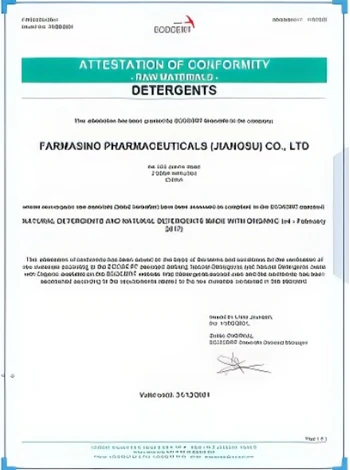



Technical Sodium Chlorite - Safe and Effective Chlorine Dioxide Precursor
Technical Sodium Chlorite An Overview
Sodium chlorite, a chemical compound with the formula NaClO2, is an inorganic compound primarily used for a variety of industrial applications, most notably in the production of chlorine dioxide. This versatile compound is produced through the reaction of sodium hydroxide with chlorine dioxide gas and is typically available as a stable, white powder or as a solution.
One of the primary uses of technical sodium chlorite is in water treatment processes. It serves as an effective disinfectant, combating pathogens such as bacteria, viruses, and protozoa in drinking water and wastewater. The effectiveness of sodium chlorite lies in its ability to release chlorine dioxide, a powerful oxidizing agent that decontaminates water without forming harmful by-products commonly associated with traditional chlorination. This has made sodium chlorite a preferred option in many municipal and industrial water treatment facilities aiming for improved water quality and safety.
In addition to water treatment, sodium chlorite is utilized in the pulp and paper industries, where it acts as a bleaching agent. Its ability to selectively oxidize lignin, the complex compound responsible for the rigidity and brown color of wood, enables pulp manufacturers to produce brighter and cleaner paper products with minimal environmental impact. This usage aligns with the industry's ongoing efforts to adopt greener and more sustainable production practices.
technical sodium chlorite

Moreover, sodium chlorite finds applications in various sectors such as textiles, food processing, and disinfection. In the textile industry, it is employed for bleaching fabrics, allowing for vibrant colors and improved fabric quality. In food processing, sodium chlorite can be used as a surface sanitizer, ensuring food safety by significantly reducing microbial contamination on food contact surfaces.
Despite its versatility and widespread applications, handling sodium chlorite requires precautions. It can be hazardous if not managed properly, as it can react with acids and other reactive substances, leading to the release of toxic gases. Thus, appropriate safety measures must be implemented in storage and usage to mitigate risks.
In conclusion, technical sodium chlorite is a valuable compound widely used across various industries for its disinfecting and bleaching properties. Its role in water treatment, pulp and paper production, textiles, and food safety highlights its significance in promoting health and environmental sustainability. As industries continue to seek safer and more effective alternatives for chemical processes, sodium chlorite remains a critical player in achieving both efficiency and safety in chemical applications.
-
Why Sodium Persulfate Is Everywhere NowNewsJul.07,2025
-
Why Polyacrylamide Is in High DemandNewsJul.07,2025
-
Understanding Paint Chemicals and Their ApplicationsNewsJul.07,2025
-
Smart Use Of Mining ChemicalsNewsJul.07,2025
-
Practical Uses of Potassium MonopersulfateNewsJul.07,2025
-
Agrochemicals In Real FarmingNewsJul.07,2025
-
Sodium Chlorite Hot UsesNewsJul.01,2025










